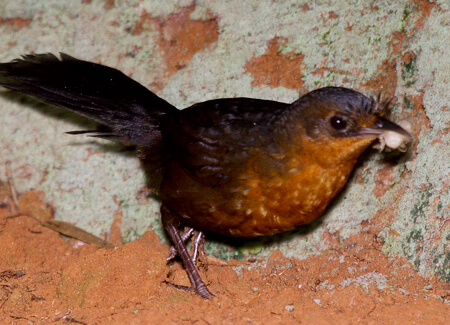
Approximate location of latest sighting.
One of the world's rarest birds, the Stresemann's Bristlefront appears to be literally one bird away from extinction. In December 2018, after months of intensive searching, a lone bristlefront was observed in Brazil. This rediscovery renews hope that this species can be saved.
Unfortunately, this Critically Endangered bird is confined to one of the most fragmented and degraded – and vulnerable – forests in the Americas.
Stresemann's Bristlefront is a long-tailed, ground-nesting songbird named for the bristly-looking tuft of feathers on its forehead. It belongs to the large family Rhinocryptidae, known as the tapaculos, native to Central and South America and notorious for their elusive habits and unresolved taxonomy.
An especially hard-to-find member of this group, the Stresemann's Bristlefront went unrecorded for 50 years after its initial discovery, then was rediscovered in 1995. Today, like the São Paulo Marsh Antwren, Blue-billed Curassow, and Esmeraldas Woodstar, this rare bird seems likely to become extinct without intensive conservation measures.
Hear the Stresemann's Bristlefront's song:
(Audio by Jon King, XC114457. Accessible at www.xeno-canto.org/114457)
Brazil's Dwindling Atlantic Forest
Five hundred years ago, the moist, lowland Atlantic Forest biome extended down the eastern coast of Brazil into Paraguay and northern Argentina. These unique forests, second only to the Amazon in biodiversity, are home to some 200 bird species found nowhere else, including the Pin-tailed Manakin and Seven-colored Tanager. Today, the Atlantic Forest is broken up into scattered patches and has been reduced to less than 10 percent of its original extent due to logging and clearing for agriculture and pasture.

Stresemann's Bristlefront female by Biodiversitas
ABC works closely with partner Fundação Biodiversitas to protect and acquire known habitat for the Stresemann's Bristlefront. In 2007, the partners created the now 2,352-acre Mata do Passarinho (Songbird Forest) Reserve to safeguard habitat for the bristlefront and other rare birds, including the lovely Banded Cotinga.
There were encouraging signs that this habitat protection was working, including the 2013 discovery of an active Stresemann's Bristlefront nest.
Unfortunately, a severe drought dried up streams and shriveled vegetation within the reserve, and in 2016, fires spread throughout the region, damaging important habitat. Although biologists conducted intensive searches for bristlefronts in the wake of these fires, none were seen throughout 2017, and the Stresemann's Bristlefront was feared lost once again.
Sign up for ABC's eNews to learn how you can help protect birds
One Last Chance?
After continued searching, a single female Stresemann's Bristlefront was observed just outside the Mata do Passarinho Reserve's boundaries in December 2018 by Alexander Zaidan of Fundação Biodiversitas and researcher Marcos Rezende Peres, who also obtained a recording of the bird. As of this writing, this is the species' only known living individual, although there remains hope that others may be found in other habitat remnants.
“Although we are relieved that the Stresemann's Bristlefront continues to survive, the species' future remains precarious,” said Amy Upgren, Alliance for Zero Extinction (AZE) Program Officer at ABC. “Much more work needs to be done to locate additional individuals and protect additional habitat.”
Searches are continuing in hopes of locating other bristlefronts, including the female's mate. To support these efforts, please give to ABC's bristlefront emergency campaign. ABC and partners are also creating an emergency action plan to protect more habitat.
Donate to support our search efforts to find more bristlefronts!



















































